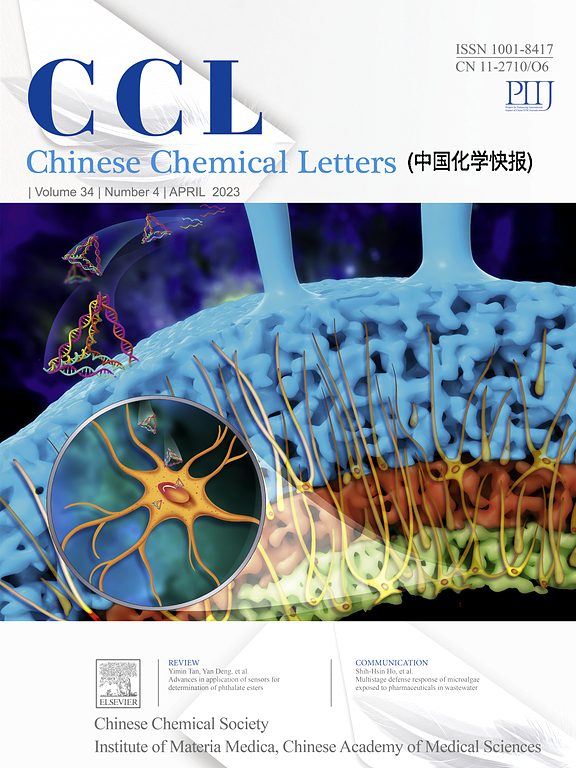Nb2O5/GCN异质结催化剂光催化可降解PBAT制备高附加值燃料:性能与机理
IF 9.4
1区 化学
Q1 CHEMISTRY, MULTIDISCIPLINARY
引用次数: 0
摘要
光催化在将塑料废物转化为有价值的化学品方面具有很大的前景。然而,单组分光催化剂上载流子的分离效率较差,限制了转化效率。在此,我们合成了一种新型ⅡNb2O5/GCN异质结,以研究其在可见光照射下(100 mW/cm2)光催化下将聚己二酸丁烯/对苯二甲酸酯(PBAT)微塑料(MPs)转化为酸和醇的效率。结果表明,ⅡNb2O5/GCN型的电荷从GCN的导带转移到Nb2O5的导带,从而提高了载体的分离效率。其中,60% %Nb2O5/GCN光催化剂处理的1.5 mg/mL PBAT MPs的乙醇生成率和乙酸生成率分别比单独处理Nb2O5高21.8倍和1.8倍。密度泛函理论计算表明,Nb2O5/GCN异质结产生的羟基自由基(•OH)将PBAT MP的酯键(OC=O)切割成单体。这些单体随后通过各种反应转化为酸和醇,包括CC键裂解、氢脱氧和CC键偶联。本研究强调了异质结光催化剂将PBAT MPs转化为有价值的化学物质的有效性,从而显著促进了生物塑料回收的进展。本文章由计算机程序翻译,如有差异,请以英文原文为准。
Photocatalytic production of high-value-added fuels from biodegradable PBAT by Nb2O5/GCN heterojunction catalyst: Performance and mechanism
Photocatalysis holds great promise for the conversion of plastic waste into valuable chemicals. However, the conversion efficiency is constrained by the poor carriers' separation efficiency over the single component photocatalyst. Herein, we synthesized a novel type Ⅱ Nb2O5/GCN heterojunction to investigate its efficiency in the photocatalytic upcycling of polybutylene adipate/terephthalate (PBAT) microplastics (MPs) into acids and alcohols under visible light irradiation (100 mW/cm2). The findings indicate that the charge transfer within the type Ⅱ Nb2O5/GCN occurs from the conduction band of GCN to the conduction band of Nb2O5, thereby enhancing the separation efficiency of carriers Notably, the rates of ethanol and acetic acid generation from 1.5 mg/mL PBAT MPs treated with the 60 %Nb2O5/GCN photocatalyst were 21.8-fold and 1.8-fold higher, respectively, compared to those by Nb2O5 alone. Density functional theory calculations demonstrate that the hydroxyl radicals (•OH) produced by the Nb2O5/GCN heterojunction cleaves the ester bond (O![]() C=O) of PBAT MP into the monomer. These monomers are subsequently converted into acids and alcohols through various reactions, including C
C=O) of PBAT MP into the monomer. These monomers are subsequently converted into acids and alcohols through various reactions, including C![]() C bond cleavage, hydrodeoxygenation, and C
C bond cleavage, hydrodeoxygenation, and C![]() C bond coupling. This study highlights the effectiveness of heterojunction photocatalyst in converting PBAT MPs into valuable chemicals, thus significantly promoting advancements in bioplastics recycling.
C bond coupling. This study highlights the effectiveness of heterojunction photocatalyst in converting PBAT MPs into valuable chemicals, thus significantly promoting advancements in bioplastics recycling.
求助全文
通过发布文献求助,成功后即可免费获取论文全文。
去求助
来源期刊

Chinese Chemical Letters
化学-化学综合
CiteScore
14.10
自引率
15.40%
发文量
8969
审稿时长
1.6 months
期刊介绍:
Chinese Chemical Letters (CCL) (ISSN 1001-8417) was founded in July 1990. The journal publishes preliminary accounts in the whole field of chemistry, including inorganic chemistry, organic chemistry, analytical chemistry, physical chemistry, polymer chemistry, applied chemistry, etc.Chinese Chemical Letters does not accept articles previously published or scheduled to be published. To verify originality, your article may be checked by the originality detection service CrossCheck.
 求助内容:
求助内容: 应助结果提醒方式:
应助结果提醒方式:


